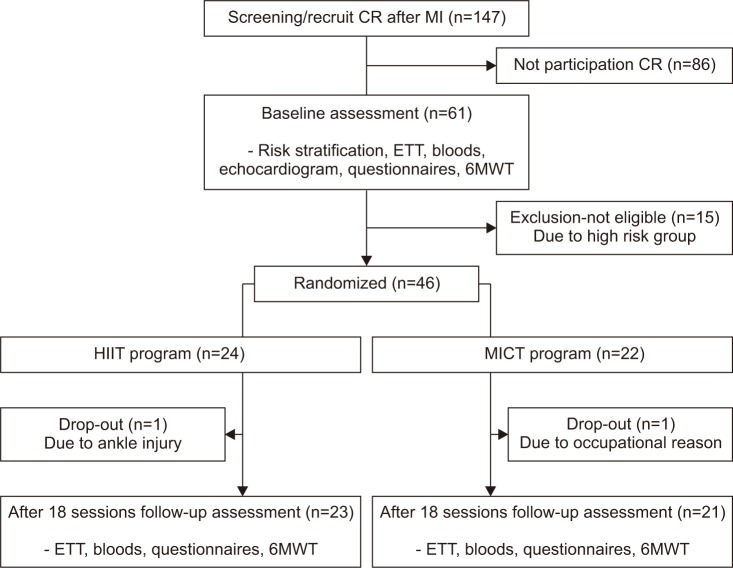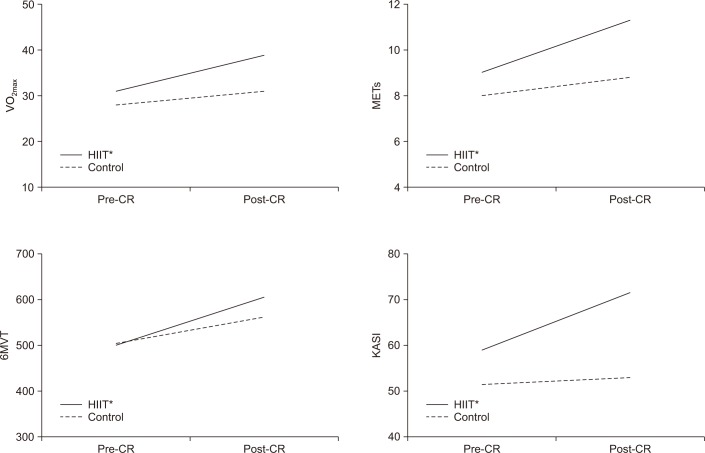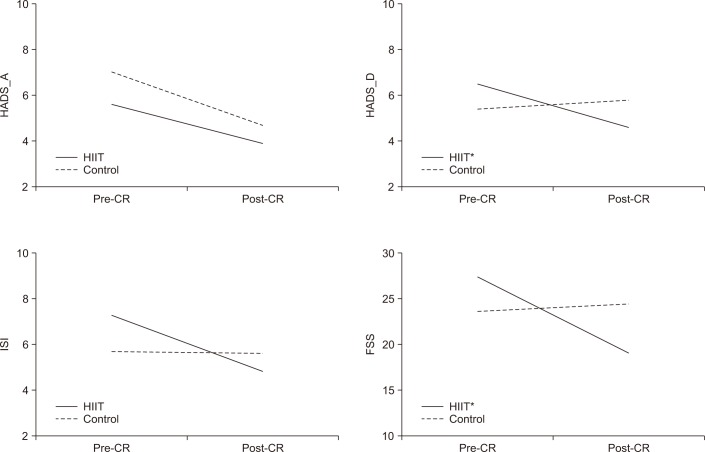Superior Effects of High-Intensity Interval Training Compared to Conventional Therapy on Cardiovascular and Psychological Aspects in Myocardial Infarction
- Affiliations
-
- 1Department of Physical and Rehabilitation Medicine, Inha University School of Medicine, Incheon, Korea. drjoakl@gmail.com
- KMID: 2440980
- DOI: http://doi.org/10.5535/arm.2018.42.1.145
Abstract
OBJECTIVE
To evaluate the effect of high-intensity interval training (HIIT) on psychological symptoms, activity states, and cardiovascular functions in patients with myocardial infarction (MI) of low and moderate risk stratification.
METHODS
This prospective study randomly allocated 44 patients with MI to 18 sessions of HIIT or conventional moderate-intensity continuous training (MICT). Outcome measures were assessed at baseline and after 18 sessions.
RESULTS
Post-exercise cardiovascular and functional states, maximal oxygen uptake (VO2max), metabolic equivalents (METs), 6-Minute Walking Test (6MWT), and Korean Activity Scale/Index (KASI) scores were significantly improved in the HIIT group compared to those in the MICT group after 18 exercise sessions. In particular, VO2max was significantly (p < 0.005) improved in the HIIT group (7.58 mL/kg/min) compared to that in the MICT group (2.42 mL/kg/min). In addition, post-exercise psychological states (i.e., scores of Fatigue Severity Scale [FSS] and depression items of the Hospital Anxiety and Depression Scale [HADS_D]) were significantly improved in the HIIT group compared to those in the MICT group after 18 exercise sessions. HADS-D was improved by 1.89 in the HIIT group compared to decrement of 0.47 in the MICT group. FSS was improved by 6.38 in the HIIT group compared to decrement of 0.77 in the MICT group (p < 0.005).
CONCLUSION
This study demonstrates that HIIT can improve cardiac function, psychological, and activity states in low and moderate risk MI patients. Compared to conventional MICT, HIIT can improve cardiovascular functions, activity states, depression, and fatigue more effectively.
Keyword
MeSH Terms
Figure
Cited by 2 articles
-
Clinical Practice Guideline for Cardiac Rehabilitation in Korea: Recommendations for Cardiac Rehabilitation and Secondary Prevention after Acute Coronary Syndrome
Chul Kim, Jidong Sung, Jong Hwa Lee, Won-Seok Kim, Goo Joo Lee, Sungju Jee, Il-Young Jung, Ueon Woo Rah, Byung Ok Kim, Kyoung Hyo Choi, Bum Sun Kwon, Seung Don Yoo, Heui Je Bang, Hyung-Ik Shin, Yong Wook Kim, Heeyoune Jung, Eung Ju Kim, Jung Hwan Lee, In Hyun Jung, Jae-Seung Jung, Jong-Young Lee, Jae-Young Han, Eun Young Han, Yu Hui Won, Woosik Han, Sora Baek, Kyung-Lim Joa, Sook Joung Lee, Ae Ryoung Kim, So Young Lee, Jihee Kim, Hee Eun Choi, Byeong-Ju Lee, Soon Kim
Korean Circ J. 2019;49(11):1066-1111. doi: 10.4070/kcj.2019.0194.Clinical Practice Guideline for Cardiac Rehabilitation in Korea
Chul Kim, Jidong Sung, Jong Hwa Lee, Won-Seok Kim, Goo Joo Lee, Sungju Jee, Il-Young Jung, Ueon Woo Rah, Byung Ok Kim, Kyoung Hyo Choi, Bum Sun Kwon, Seung Don Yoo, Heui Je Bang, Hyung-Ik Shin, Yong Wook Kim, Heeyoune Jung, Eung Ju Kim, Jung Hwan Lee, In Hyun Jung, Jae-Seung Jung, Jong-Young Lee, Jae-Young Han, Eun Young Han, Yu Hui Won, Woosik Han, Sora Baek, Kyung-Lim Joa, Sook Joung Lee, Ae Ryoung Kim, So Young Lee, Jihee Kim, Hee Eun Choi, Byeong-Ju Lee, Soon Kim
Ann Rehabil Med. 2019;43(3):355-443. doi: 10.5535/arm.2019.43.3.355.
Reference
-
1. World Health Organization. The top 10 causes of death (Fact Sheet No. 310). Geneva: World Health Organization;2017.2. Bartels MN, Bourne GW, Dwyer JH. High-intensity exercise for patients in cardiac rehabilitation after myocardial infarction. PM R. 2010; 2:151–155. discussion 155. PMID: 20193943.
Article3. Lawler PR, Filion KB, Eisenberg MJ. Efficacy of exercise-based cardiac rehabilitation post-myocardial infarction: a systematic review and meta-analysis of randomized controlled trials. Am Heart J. 2011; 162:571–584. PMID: 21982647.
Article4. Balady GJ, Williams MA, Ades PA, Bittner V, Comoss P, Foody JM, et al. Core components of cardiac rehabilitation/ secondary prevention programs: 2007 update. A scientific statement from the American Heart Association Exercise, Cardiac Rehabilitation, and Prevention Committee, the Council on Clinical Cardiology; the Councils on Cardiovascular Nursing, Epidemiology and Prevention, and Nutrition, Physical Activity, and Metabolism; and the American Association of Cardiovascular and Pulmonary Rehabilitation. Circulation. 2007; 115:2675–2682. PMID: 17513578.5. Rognmo O, Hetland E, Helgerud J, Hoff J, Slordahl SA. High intensity aerobic interval exercise is superior to moderate intensity exercise for increasing aerobic capacity in patients with coronary artery disease. Eur J Cardiovasc Prev Rehabil. 2004; 11:216–222. PMID: 15179103.
Article6. Guiraud T, Juneau M, Nigam A, Gayda M, Meyer P, Mekary S, et al. Optimization of high intensity interval exercise in coronary heart disease. Eur J Appl Physiol. 2010; 108:733–740. PMID: 19915859.
Article7. Fletcher GF, Balady GJ, Amsterdam EA, Chaitman B, Eckel R, Fleg J, et al. Exercise standards for testing and training: a statement for healthcare professionals from the American Heart Association. Circulation. 2001; 104:1694–1740. PMID: 11581152.8. Warburton DE, McKenzie DC, Haykowsky MJ, Taylor A, Shoemaker P, Ignaszewski AP, et al. Effectiveness of high-intensity interval training for the rehabilitation of patients with coronary artery disease. Am J Cardiol. 2005; 95:1080–1084. PMID: 15842976.
Article9. Munk PS, Staal EM, Butt N, Isaksen K, Larsen AI. High-intensity interval training may reduce in-stent restenosis following percutaneous coronary intervention with stent implantation: a randomized controlled trial evaluating the relationship to endothelial function and inflammation. Am Heart J. 2009; 158:734–741. PMID: 19853690.10. Lichtman JH, Bigger JT Jr, Blumenthal JA, Frasure-Smith N, Kaufmann PG, Lesperance F, et al. Depression and coronary heart disease: recommendations for screening, referral, and treatment. A science advisory from the American Heart Association Prevention Committee of the Council on Cardiovascular Nursing, Council on Clinical Cardiology, Council on Epidemiology and Prevention, and Interdisciplinary Council on Quality of Care and Outcomes Research: endorsed by the American Psychiatric Association. Circulation. 2008; 118:1768–1775. PMID: 18824640.11. Kooistra M, van der Graaf Y, Grool AM, Zuithoff NP, Jan Biessels G, Geerlings MI, et al. The natural course of elevated levels of depressive symptoms in patients with vascular disease over eight years of follow-up. The SMART-Medea study. J Affect Disord. 2016; 202:95–101. PMID: 27259081.
Article12. Huffman JC, Celano CM, Beach SR, Motiwala SR, Januzzi JL. Depression and cardiac disease: epidemiology, mechanisms, and diagnosis. Cardiovasc Psychiatry Neurol. 2013; 2013:695925. PMID: 23653854.
Article13. O'connor CM, Gurbel PA, Serebruany VL. Depression and ischemic heart disease. Am Heart J. 2000; 140(4 Suppl):63–69. PMID: 11011350.14. Wenger NK. Current status of cardiac rehabilitation. J Am Coll Cardiol. 2008; 51:1619–1631. PMID: 18436113.
Article15. Yohannes AM, Doherty P, Bundy C, Yalfani A. The long-term benefits of cardiac rehabilitation on depression, anxiety, physical activity and quality of life. J Clin Nurs. 2010; 19:2806–2813. PMID: 20738450.
Article16. Milani RV, Lavie CJ. Impact of cardiac rehabilitation on depression and its associated mortality. Am J Med. 2007; 120:799–806. PMID: 17765050.
Article17. Duarte Freitas P, Haida A, Bousquet M, Richard L, Mauriege P, Guiraud T. Short-term impact of a 4-week intensive cardiac rehabilitation program on quality of life and anxiety-depression. Ann Phys Rehabil Med. 2011; 54:132–143. PMID: 21397582.
Article18. Moholdt T, Madssen E, Rognmo O, Aamot IL. The higher the better? Interval training intensity in coronary heart disease. J Sci Med Sport. 2014; 17:506–510. PMID: 23938444.
Article19. Sung J, On YK, Kim HS, Chae IH, Sohn DW, Oh BH, et al. Development of Korean Activity Scale/Index (KASI). Korean Circ J. 2000; 30:1004–1009.
Article20. Hlatky MA, Boineau RE, Higginbotham MB, Lee KL, Mark DB, Califf RM, et al. A brief self-administered questionnaire to determine functional capacity (the Duke Activity Status Index). Am J Cardiol. 1989; 64:651–654. PMID: 2782256.
Article21. Zigmond AS, Snaith RP. The hospital anxiety and depression scale. Acta Psychiatr Scand. 1983; 67:361–370. PMID: 6880820.
Article22. Kroenke K, Spitzer RL, Williams JB. The PHQ-9: validity of a brief depression severity measure. J Gen Intern Med. 2001; 16:606–613. PMID: 11556941.23. Valko PO, Bassetti CL, Bloch KE, Held U, Baumann CR. Validation of the fatigue severity scale in a Swiss cohort. Sleep. 2008; 31:1601–1607. PMID: 19014080.
Article24. Bastien CH, Vallieres A, Morin CM. Validation of the Insomnia Severity Index as an outcome measure for insomnia research. Sleep Med. 2001; 2:297–307. PMID: 11438246.
Article25. Thevenet D, Tardieu M, Zouhal H, Jacob C, Abderrahman BA, Prioux J. Influence of exercise intensity on time spent at high percentage of maximal oxygen uptake during an intermittent session in young endurance-trained athletes. Eur J Appl Physiol. 2007; 102:19–26. PMID: 17851682.
Article26. Shaw LJ, Olson MB, Kip K, Kelsey SF, Johnson BD, Mark DB, et al. The value of estimated functional capacity in estimating outcome: results from the NHBLI-sponsored Women's Ischemia Syndrome Evaluation (WISE) Study. J Am Coll Cardiol. 2006; 47(3 Suppl):S36–S43. PMID: 16458169.27. Johnston M, Foulkes J, Johnston DW, Pollard B, Gudmundsdottir H. Impact on patients and partners of inpatient and extended cardiac counseling and rehabilitation: a controlled trial. Psychosom Med. 1999; 61:225–233. PMID: 10204976.28. Korzeniowska-Kubacka I, Bilinska M, Piotrowska D, Stepnowska M, Piotrowicz R. The impact of exercise-only-based rehabilitation on depression and anxiety in patients after myocardial infarction. Eur J Cardiovasc Nurs. 2017; 16:390–396. PMID: 27899438.
Article29. Evangelista LS, Moser DK, Westlake C, Pike N, Ter-Galstanyan A, Dracup K. Correlates of fatigue in patients with heart failure. Prog Cardiovasc Nurs. 2008; 23:12–17. PMID: 18326992.
Article30. Kim YJ, Rogers JC, Raina KD, Callaway CW, Rittenberger JC, Leibold ML, et al. An intervention for cardiac arrest survivors with chronic fatigue: a feasibility study with preliminary outcomes. Resuscitation. 2016; 105:109–115. PMID: 27255956.
Article
- Full Text Links
- Actions
-
Cited
- CITED
-
- Close
- Share
- Similar articles
-
- Comparison of the Effects of Highintensity Statin Therapy with Moderate-Intensity Statin and Ezetimibe Combination Therapy on Major Adverse Cardiovascular Events in Patients with Acute Myocardial Infarction: a Nationwide Cohort Study
- Cardiovascular diseases and sports medicine
- Clinical application of stem cell in cardiovascular diseases
- Stem Cells for Cardiovascular Disease
- Acute Myocardial Infarction in a Young Man; Fatal Blow of the Marijuana: A Case Report





